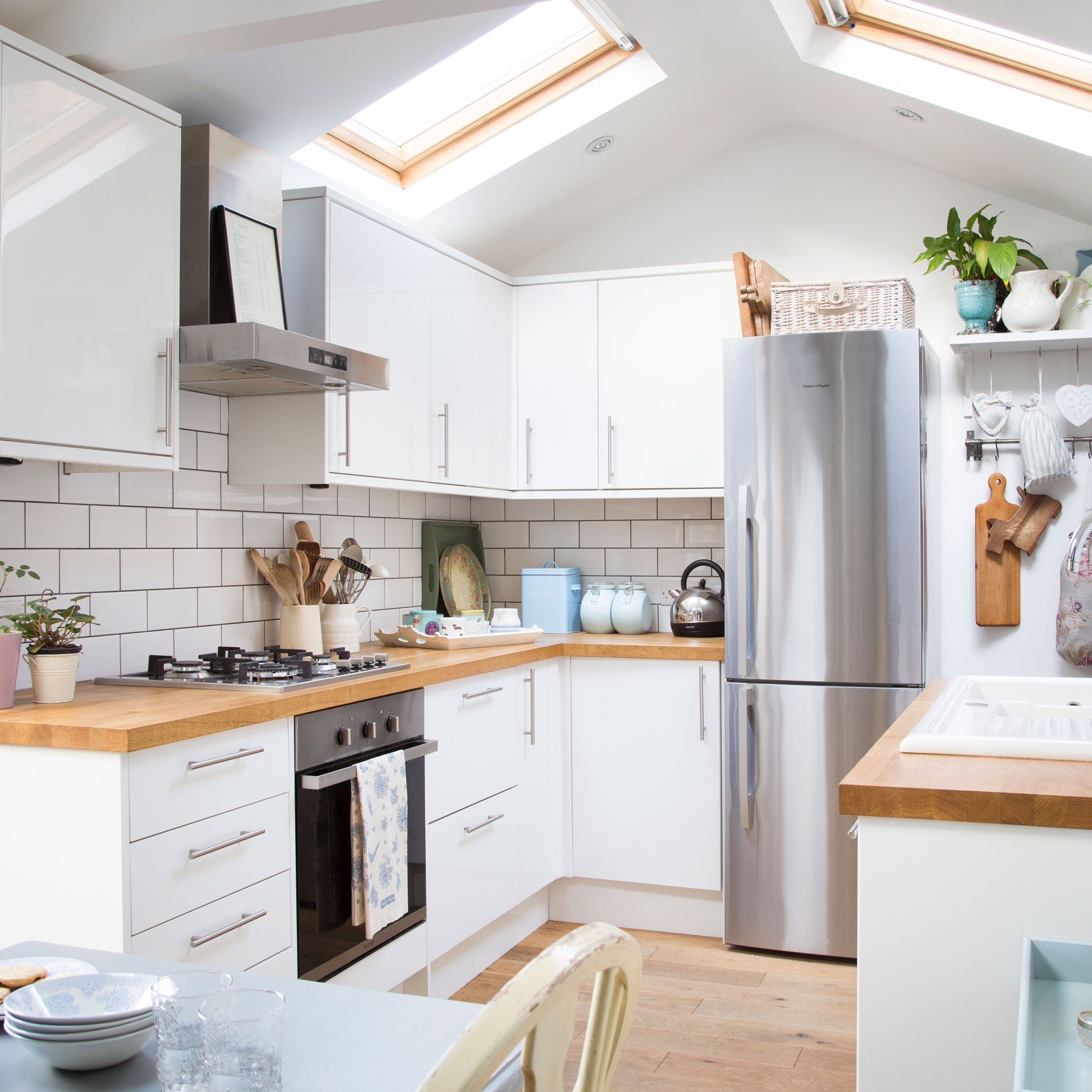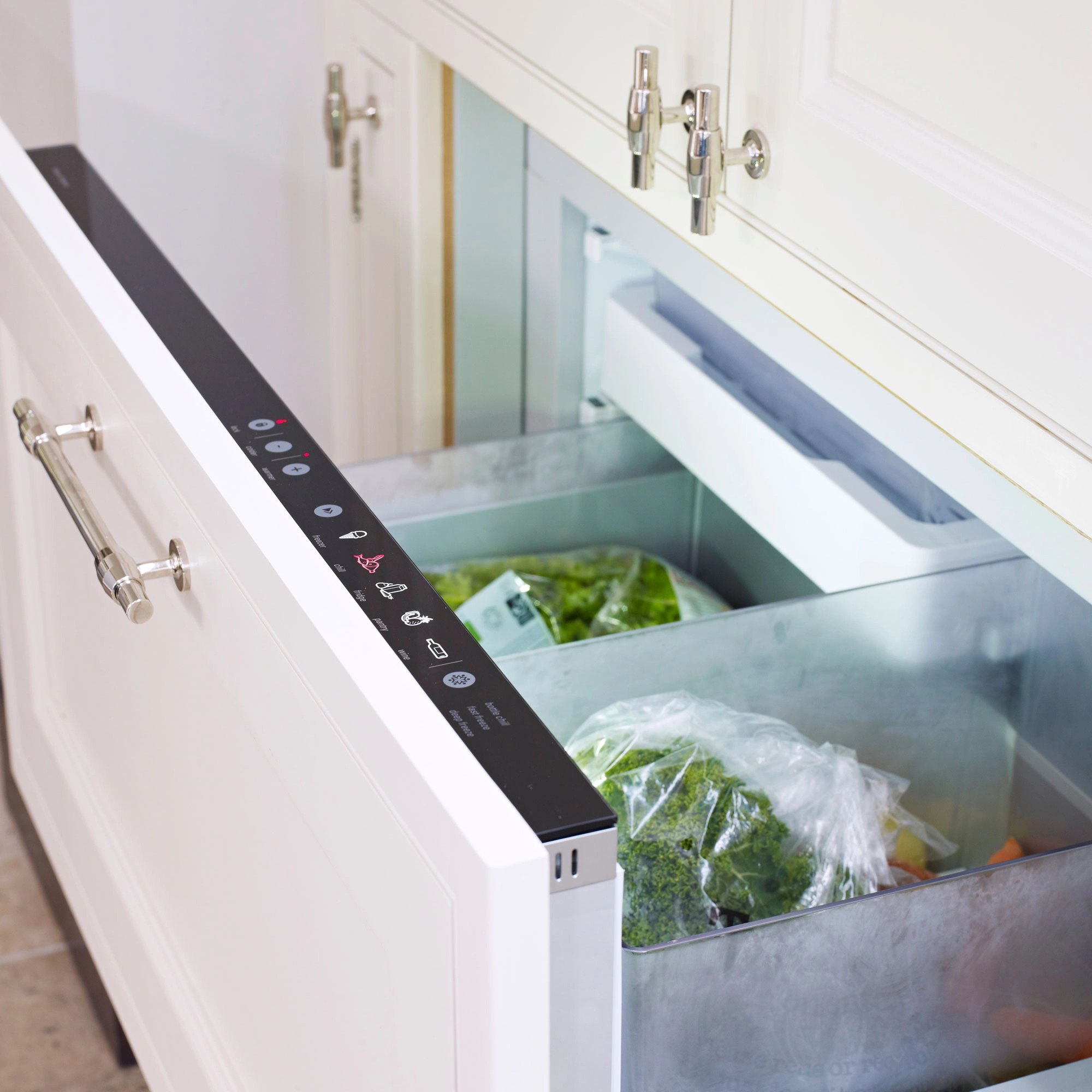
When it comes to the upkeep of your kitchen appliances, one of the most useful things to learn is how to defrost a freezer to keep it running smoothly and your food safely stored. Over time, layers of frost can build up, reducing storage space and making your appliance work harder than it needs to, increasing the cost to run your fridge freezer than it really should.
A lot of modern freezers have a frost-free feature so when you open the door and warm air goes in, an automatic fan will remove the warm air so it doesn't condense into water and freeze-producing ice. However, older freezers without this feature will suffer from a build-up of ice over time which will require defrosting.
And if you're wondering why ice is building up in your freezer, it's time to tackle it. A build-up of ice in your freezer will most definitely waste more energy and increase your bills, so defrosting your freezer is important for its functionality saving you energy and money.

What you’ll need
A large cool box is great to have for your picnic arsenal and it comes in really handy when defrosting your freezer as it'll keep all your frozen food at the right temp while you finish the job.
These reusable freezer ice packs will keep your frozen items at the right temperature while you defrost the freezer. Just chuck them in the freezer before you start the task to get them ready for your cool box.
When defrosting a freezer, you'll need some absorbent cloths to hand to mop up all the melting ice. These microfibre cloths are just the ticket. They're also perfect for cleaning your freezer when it's properly thawed out.
Step-by-step

1. Check your instruction manual
A common question is ‘can you defrost a freezer without turning it off?’ The answer is, yes it can be done but you have to be very careful and make sure doing so will be safe for your particular model.
Anna Batten, product manager at Smeg also says there are no quick fixes when it comes to defrosting your freezer. ‘Defrosting a freezer should be done as per the instruction manual of the appliance, otherwise, you risk damaging the appliance. Electrical appliances, such as hair dryers, or defrost sprays should not be used to speed up the defrosting process as this risks parts becoming damaged.’
Before you start defrosting your best fridge freezer double check your appliance’s instruction manual in case it contains any instructions or tips that are specific to your freezer.
We know these manuals are easy to misplace, so it'll likely be online if you can’t find yours.
2. Turn down your thermostat
'A few hours before defrosting, set the thermostat to the lowest temperature in order to further lower the temperature of the frozen foods,' advises Anna from Smeg.
It’s best if you start your defrosting process when you have fewer items in the freezer so it will be easier to find a different place for your frozen food to prevent it from thawing out. Or get yourself a good-size cool box to house your food, or even ask neighbours to help you store it for a while.
'The first thing to do when beginning to defrost your freezer is to empty it out and switch it off at the mains,' advises Ian Palmer-Smith, appliance expert at Domestic & General. 'You can then leave the door open and let the defrosting commence.'
'A top tip is to make sure the room is quite warm, to help speed up the thawing process.'

3. Turn the freezer off
Make sure you turn off your freezer at the mains and secure the cable and plug so there is no risk of either coming into contact with any water once the ice starts melting. Once you have removed all your food and placed them in cool bags - or sneaky tip newspaper - leave the doors open so warm air can start circulating and melting the ice.
Lara Brittain, a kitchen expert from Currys, advises a way to speed up the process, ‘Place a bowl of hot water at the bottom of the freezer with the door open. This will help speed up the defrosting process. Once the water is no longer steaming, replace it.
4. Lay down towels
Depending on how long it’s been since your last defrosting, you may have a lot of ice to get rid of and therefore a lot of water. Place towels, or absorbent cloths like microfibre, down in front of your freezer to soak up water, but also keep some spare towels aside to mop up any excess water.
'To stop your room from becoming one big puddle, add towels along the floor in front of the freezer,' Ian suggests.
'Even a thin layer of ice in your freezer can produce a lot more water than you may expect.'
5. Give your freezer a clean
Once all the ice has melted, use warm water to clean the freezer and drawers and wipe down with a dry kitchen cloth or towel to finish.
Check everything is bone dry because any leftover moisture will freeze.
'Water left over in the freezer will turn to ice when you switch the appliance back on, so it’s important to take time to fully dry the appliance out,' explains Ian. 'Give the freezer a thorough wipe down with an absorbent cloth to make sure no excess water is left behind.'

6. Plug it back in
What should you not do when defrosting a freezer?

'Turn the power back on and wait for the freezer to reach the proper temperature before refilling the appliance,' says Anna from Smeg.
But what temperature should a freezer be? It's recommended to keep your freezer at around -18ºC; once it has reached that temperature you can refill it. Consider some kitchen storage ideas to keep your freshly defrosted freezer in order.
‘The best energy-saving hack is to keep your freezer full,’ says Jordan Chance, heating expert from PlumbNation. ‘When your freezer is full, there is less room for warmer air to take up. The items that are already in your freezer will help to cool down any air that does sneak in.
‘It is important to find a happy medium when stocking your freezer - as too much food could also block the cold airflow. We recommend leaving approximately an inch-worth of space between your frozen food items and the interior sides and roof of your freezer.’
1. Avoid salt
Don’t use salt to defrost your freezer - 'Yes, salt does help clear icy roads but it can also corrode your freezer elements, seals and linings,' cautions Laura from Currys.
2. Don't use metal tools
‘Never try to be too forceful when clearing ice and especially don’t use metal tools. You’ll very likely do permanent damage to your fridge freezer,' says Laura.
Once the ice has started to thaw, you could run a plastic or wooden spatula under a hot tap and use it to gently remove the ice. There are also various plastic ice scrapers available at Amazon to help you remove ice, but be gentle as you don't want to damage the cooling elements.
3. Avoid using sharp objects
'Although it may be tempting to hack at the ice with a sharp object, you may end up causing some serious damage to your appliance,' warns Mark Grieg head of supplier management at Marks Electrical.
'Avoid using knives or any other sharp, heavy object to scrape the ice off the edges as there is a very high possibility you could puncture the walls of your freezer, making the appliance unusable.' A freezer puncture could cause your freezer to malfunction, the temperature to fluctuate and all of your food to spoil.’
FAQs
How often should you defrost a freezer?
To keep it in tip-top condition depends on how often you should defrost your freezer, it's imperative to defrost it at least once a year.
'You should aim to defrost your freezer once a year. Regular defrosting helps maintain optimal performance and efficiency,' explains Rachael Kiss, from Alliance Online.
Valerie Posner, head of business unit, refrigeration, at BSH Home Appliances adds that how you use your freezer will affect how often you need to defrost it.
‘If you are the type of person that regularly stands in front of the freezer with the door open for prolonged periods, or often put still-warm items inside the freezer, this will allow moisture to form in the cavity. This added moisture will turn to ice, which can build up and then will need removing for the freezer to function efficiently.’
But ideally, you should aim to defrost your freezer at least once a year, or when the build-up of ice is thicker than 6mm says kitchen expert Lara. 'This will keep it working efficiently – and more importantly, will keep your food accessible at all times!'
Knowing how to defrost your freezer is a crucial part of the cleaning of your home and these tips will make it quick and easy.
How long does a freezer take to defrost?
Patience is key when defrosting a freezer, and it depends on the size of your appliance and just how bad the ice build-up is.
If a freezer has been left open for several days, you might have an Ice Age situation that takes longer than just a bit of frosty build-up. Generally speaking, it shouldn't take more than a few hours.
Do you leave the freezer door open when defrosting?
Experts have very differing opinions on whether to leave your freezer open or closed while defrosting.
Sarah Heaps, AO.com's refrigeration expert says, 'It’s a wise idea to leave the freezer door open during defrosting, as it will allow warm air to enter the cool appliance and speed up the thawing process.'
However, Rachael from Alliance Online disagrees. 'Ideally, you shouldn’t leave the freezer door open when defrosting it. When you defrost your freezer, it’s best to keep the door closed to maintain a more controlled environment and speed up the thawing process. But, overall, leaving the door open or closed doesn’t make a huge difference.'
What happens if you don't defrost a freezer?
Rachael Kiss from Alliance Online explains why it's so important to defrost your freezer.
- Reduced energy efficiency - 'Accumulated ice in the freezer can act as an insulator, making the appliance less energy-efficient. The compressor has to work harder to maintain the desired temperature, leading an increase in the cost to run your fridge freezer than it really should. to increased energy consumption and higher electricity bills.'
- Decreased storage capacity - 'If ice buildup takes up space inside the freezer, it reduces the available storage capacity. This means less room to store frozen foods.'
- Poor temperature control - 'Ice buildup can interfere with the freezer's ability to maintain a consistent and uniform temperature. This means uneven freezing can lead to food being spoiled.'
- Potential damage to the freezer - 'In very severe cases, neglecting to defrost a freezer for an extended period of time can lead to mechanical issues. The excessive workload of the compressor may cause it to overheat, reducing the lifespan of the appliance.'







